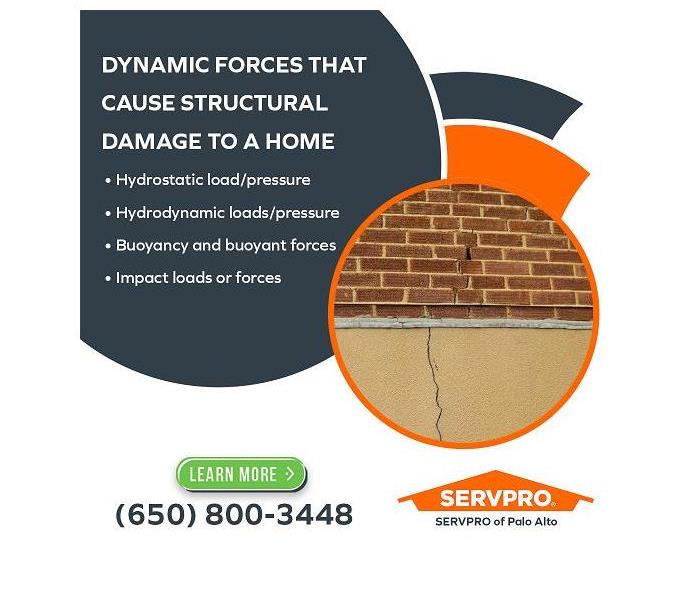How the Forces of Floodwaters Can Damage a Home and Cause Severe Water Damage?
11/24/2022 (Permalink)
Blog Summary: SERVPRO of Palo Alto highlights the damage that severe flooding can have on a home.
SERVPRO® of Palo Alto specializes in seasonal hazards and restoration for homes and businesses in the Bay area. The team utilizes the latest equipment, cutting-edge moisture-detecting technology, advanced cleaning techniques, and EPA-approved cleaning products to make the disaster like it never happened.
Floodwaters are a powerful force capable of causing great destruction. Homeowners and prospective home buyers should familiarize themselves with the dynamic forces that cause structural damage to a home. This knowledge will ensure the scope of the post-disaster inspection will identify the range of flood damage.
Hydrostatic load/pressure
Some floods involve rising water, much like a bathtub filled with water. These relatively calm waters exert hydrostatic pressure, which refers to the force exerted by still water against a structure’s foundation, wall, slab, or basement wall. The static pressure is powerful, stressing a foundation or causing water to flow through fissures or cracks in walls.
The pressure can accelerate seepage through solid concrete, which is surprisingly porous. Equilibrium is achieved if the water level on the exterior of the structure is identical to the water level inside the structure. This balance may translate into less severe structural damage.
Hydrodynamic loads/pressure
Hydrodynamic pressure is the force exerted by water in motion. Floodwater flowing around a home generates hydrodynamic pressure on the structure. The forces exerted are directly related to the velocity of the water. The faster the water flows, the greater the pressure exerted where the water collides with the structure. A suction or vacuum force occurs on the backside of the home, opposite the impact zone.
If flowing water impacts a home at an angle, this lateral pressure is quite destructive. Walls can separate, and floors break up. The home may shift off its foundation or possibly suffer a catastrophic failure and collapse into a heap of rubble carried away by the current of the floodwaters.
Buoyancy and buoyant forces
Buoyancy refers to the capacity to float. Vehicles are very buoyant and are often seen floating in the current of floodwaters. Rising floodwaters create buoyant forces that can float a home off its foundation. Homes with pier and beam foundations or raised foundations are more vulnerable to these uplifting forces. In some instances, the connection points to the foundation may not be strong enough to keep the structure moored to its foundation.
Many homes are largely constructed of wood. Wood-framed walls, floors, and roofs are highly buoyant. A home can quickly become a floating barge, and cars can become water-born in only two feet of water.
Impact loads or forces
Impact load refers to the forces exerted when a floating object crashes into a home. The sudden jolt can be catastrophic. Impact loads include water current, waves, turbulence, and floating debris. The debris may be vehicles, other structures, trees, tree trunks, limbs, furniture, and propane tanks. Alone or in combination with other floating items, any of this debris can torpedo a home, knocking it off its foundation or ripping off sections of the structure. Floor joists, rafters, trusses, wood floors, framing timber, and walls can suffer significant damage. Floors buckle. The roof may suffer catastrophic failure and collapse.
Illustrating the force of floodwaters
Some floodwaters are calm and still, rising like water in a pool or bathtub. Some floodwaters are rushing, turbulent rivers destroying anything and everything in their path. In both cases, the forces exerted by water are extreme. The walls, foundation, and flooring are no match for the power of floodwaters.
These examples illustrate the tremendous dynamic force of water. When the water level on the exterior of the home is three feet higher than the water inside the house, the inward pushing pressure exerted on the structure is roughly 180 to 200 pounds per square foot. The pressure against a home with walls 50 feet long and 10 feet high could destroy the house. Flood water traveling at a velocity of 10 miles per hour impacts a structure with the similar force of a wind gust of 270 miles per hour! Severe flooding has the power to uproot trees, wash out roads and bridges, and demolish homes and businesses.
When severe weather brings flooding and storm damage, reach out to the storm damage cleanup and restoration professionals at SERVPRO of Palo Alto. Available 24/7, 365 days a year, crews arrive on the scene in about an hour. The rapid response and quick cleanup reduce advanced secondary damage while getting life back to normal as soon as possible.
Contact SERVPRO® of Palo Alto to learn more about storm damage restoration. The office can be reached by calling (650) 800-3448 or emailing office@SERVPROpaloalto.com.



 24/7 Emergency Service
24/7 Emergency Service
